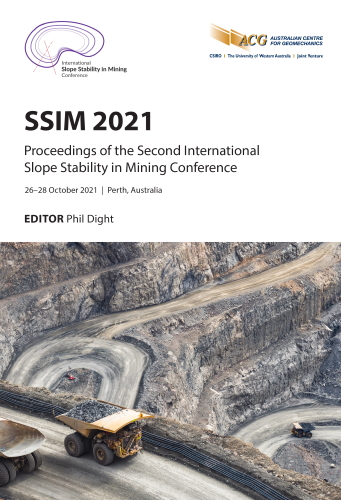Improving reliability of the geotechnical model for Cenozoic cover sequence sediments in the Pilbara, Western Australia

|
Authors: Noble, DP; Hemraj, DJ; Eggers, MJ |
DOI https://doi.org/10.36487/ACG_repo/2135_23
Cite As:
Noble, DP, Hemraj, DJ & Eggers, MJ 2021, 'Improving reliability of the geotechnical model for Cenozoic cover sequence sediments in the Pilbara, Western Australia', in PM Dight (ed.), SSIM 2021: Second International Slope Stability in Mining, Australian Centre for Geomechanics, Perth, pp. 373-386, https://doi.org/10.36487/ACG_repo/2135_23
Abstract:
This paper presents a case study of the ongoing development of the geotechnical model in Cenozoic cover sequence sediments for a large open pit operation located in the Pilbara region of Western Australia. Model development involves a novel approach that couples the resource geochemistry and downhole geophysics database with traditional geotechnical cored drilling methods. The objective is to manage uncertainty in pit design due to variability in the distribution of geotechnical units in the Cenozoic cover sequence sediments. The operation comprises a series of open pits with an areal coverage of approximately 27 km by up to 8 km. The deposit is covered by a 100 m thick Cenozoic-aged sequence of sediments comprising mudstones, clays, and conglomerates, much of which is below the groundwater table. Challenges for developing the geotechnical model include: The modelling approach comprises comparing selected reverse circulation (RC) resource drill results against adjacent diamond core drilling with detailed geotechnical logging. The aim is to characterise the key geochemical and geophysical signatures for the major geotechnical units. These signatures are then applied to selected sections through the resources drilling database from which the geotechnical model is interpreted. Developing an understanding of the geological history and the spatial variability of the resulting Cenozoic cover sequence is important to the model development. The resulting model is used to guide slope stability and hydrogeological analyses in areas identified as critical to slope performance. The outcome is optimising the slope design with steepening of inter-ramp angles in some areas and developing pit slope risk management strategies to be applied during mining.
Keywords: Cenozoic sediments, geotechnical model, Pilbara, slope design
References:
Baxter, H 2016, ‘Geophysics, geochemistry and engineering geology: how disciplines combine to improve mine slope design in the Pilbara detrital valleys of Western Australia’, Engineering Geology Special Publications, Geological Society, London, vol. 27, pp. 81–92.
Hemraj, D 2018, ‘Engineering geological modelling of the Archean – Cenozoic unconformity in the Pilbara and implications to open pit slope design’, Proceedings of the 13th Australia – New Zealand Conference on Geomechanics, Australian Geomechanics Society, Perth, pp. 923–929.
Hemraj, D & Eggers M, 2020, ‘Development of a Geotechnical Model for Open Pit Slope Design in Cenozoic Sediment, Pilbara Region of Australia’, Western AGS Symposium, Australian Geomechanics Society.
Morris, R & Ramanaidou, E 2007, ‘Genesis of the channel iron deposits (CID) of the Pilbara region, Western Australia’, Australian Journal of Earth Sciences, vol. 54, pp. 733–756.
Thorne, W, Haremann, S, Webb, A & Clout, J 2008, ‘Banded iron formation-related iron deposits of the Hamersley Province, Western Australia’, Review in Economic Geology, vol. 15, pp. 197–221.
© Copyright 2025, Australian Centre for Geomechanics (ACG), The University of Western Australia. All rights reserved.
View copyright/legal information
Please direct any queries or error reports to repository-acg@uwa.edu.au
View copyright/legal information
Please direct any queries or error reports to repository-acg@uwa.edu.au